barbarian invasions
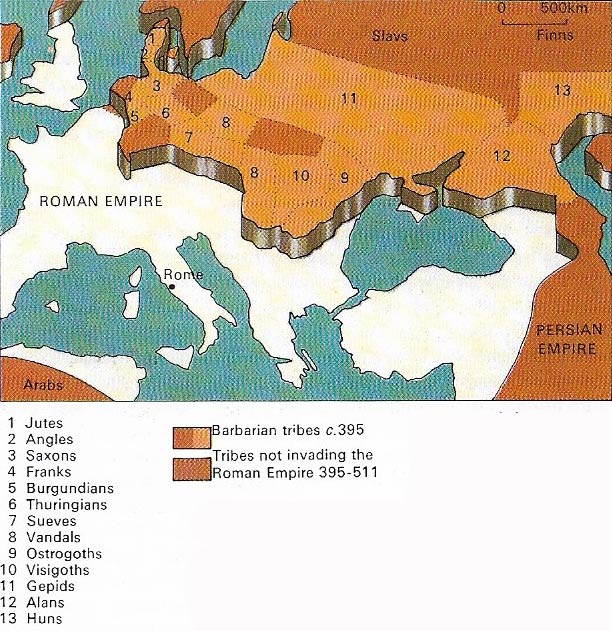
Figure 1. The positions of the barbarian tribes to the east of the Roman frontier along the Rhine and Danube rivers changed constantly. The pressure on Rome's increasingly ill-defended northeastern frontier was kept up by the arrival of new warring peoples who were impelled relentlessly westwards from Central Asia by hunger and nomadic life style. The Huns invaded Italy in 452.
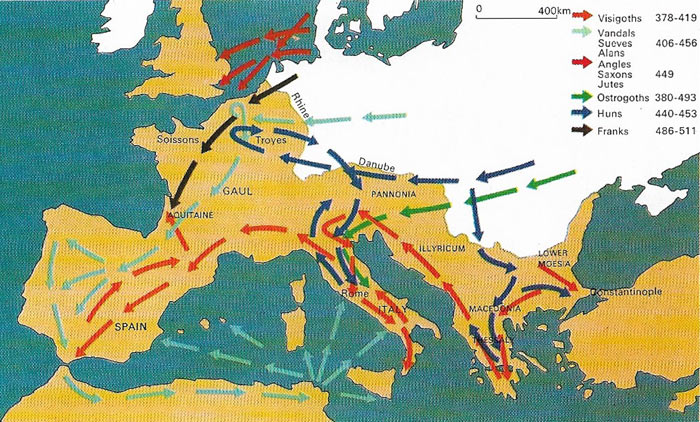
Figure 2. A chaotic wandering of barbarians within the confines of the Western Empire followed the collapse of the Rhine and Danube frontier. The barbarians, although quite uncoordinated, had four targets: Constantinople, Macedonia and Thrace; Italy; northeastern Roman Gaul; and North Africa, the granary of the Western Empire. Without any preconceived plan of attack, the citadels of the empire fell according to a domino pattern. Westward pressure was intensified as more tribes arrived from the east, in particular the Huns. The crucial blow to the empire was the Vandal invasion of Africa which, by 429, left Rome surrounded and the Vandals controlling the western Mediterranean.
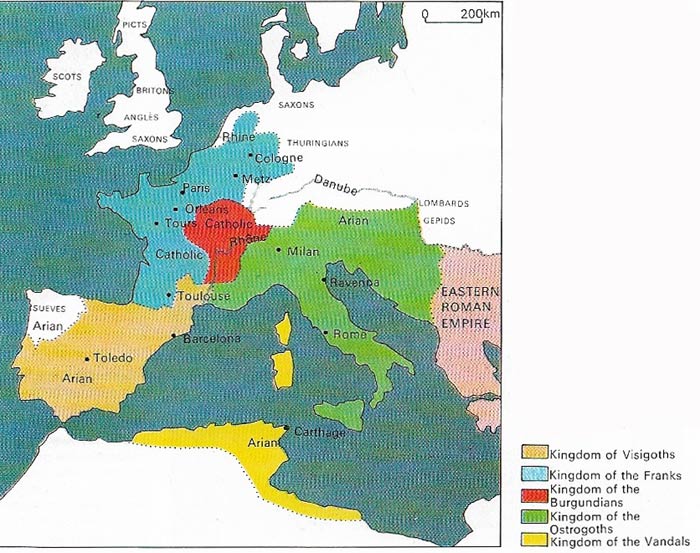
Figure 3. The barbarians gradually formed independent kingdoms in the west. They expropriated some property but left much of the Roman landed aristocracy and administration intact. Roman and Teutonic societies existed side by side in an uneasy balance, the military strength of the invaders bringing the defensive capacity that defeated the Huns in 452. The Huns remained nomadic and never founded a lasting kingdom. The barbarian kingdoms were the origins of the national boundaries of medieval western Europe.
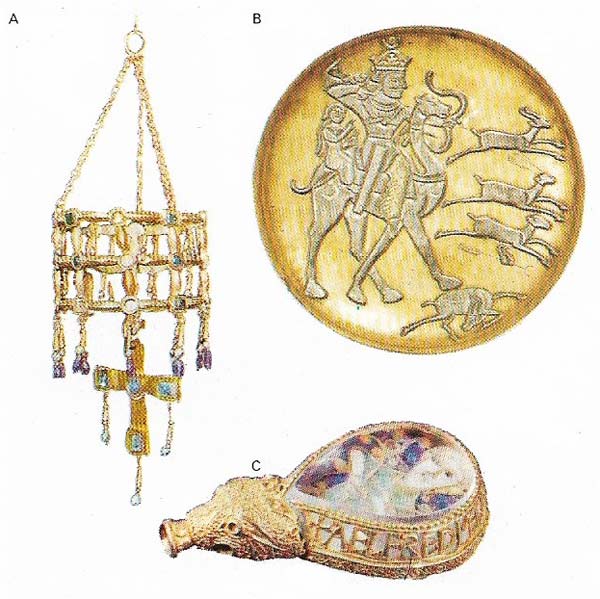
Figure 4. The highest achievement of barbarian art was in its metalwork. The 6th-century silver-gilt dish from Sassanian Persia (B) was the equal of any contemporary east Roman metalwork. In the west, work ranged from the sternly Teutonic Visigothic crown (A) to the Anglo-Saxon Alfred Jewel (C). This is made of continental cloisonne enamel and has classical motifs and a figure of Spring (or Christ).
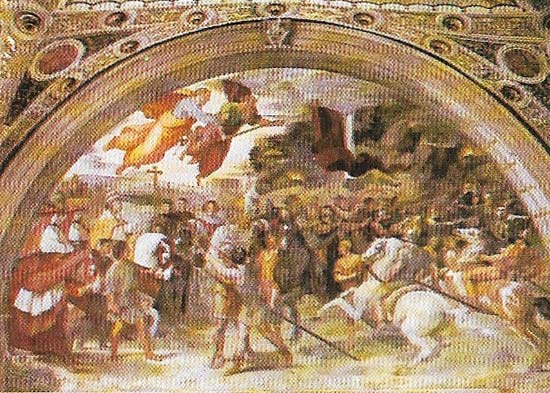
Figure 5. Rachael's fresco of "The Repulse of "Attila" (1513) shows Attila and his Huns confronted by Pope Leo I, protected only by the miraculous intervention of St Peter and St Paul. Attila, repulsed by the Romans and Visigoths near Troyes in 452 and by Leo in Italy, retires to Pannonia and died on his wedding night of a burst blood vessel – four events which saved the legacy of Roman civilization.
"Barbarian" was a term abused by the Romans to describe anyone outside the Mediterranean civilization of Greece and Rome. Since the time of Caesar the frontiers of the Roman Empire had been menaced by invading Germanic peoples, many of whom were conquered, after which they settled as fairly peaceable – though armed – colonists.
The frontier that extended from the North Sea to the Black Sea via the Rhine and Danube was under renewed pressure in the 4th century from a fresh wave of hostile German peoples: Franks, Saxons, Burgundians, Visigoths, Ostrogoths, Sueves, Alans, Vandals, and Gepids (Figure 1). Their societies were based on the clan and their tribes were relatively small in number, ranging from about 25,000 to 120,000; all able-bodied men were soldiers and farming was done by slaves. Their armies, supported by a powerful cavalry, proved too strong for the last of the Roman legions. The barbarians were converts to Arianism, a heresy abhorrent to orthodox Christians because it denied Christ's divinity. The westward pressure of these peoples at the end of the 4th century was due to overpopulation and storage of food as well as the arrival of the Huns, a fierce nomadic Mongol people from Central Asia who came to pillage rather than to settle.
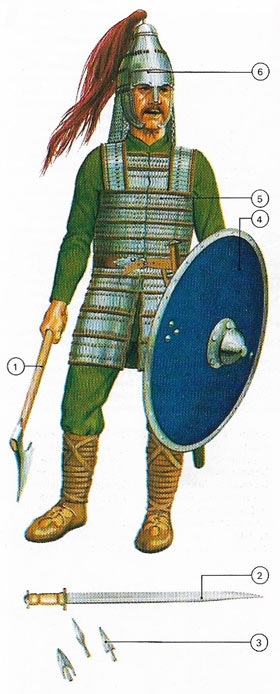 |
| At the time of their invasion of Gaul in the 5th century, all freemen within the Frankish tribe were warriors. The Frankish army was mainly infantry rather than cavalry. Their most redoubtable weapon was the battle axe, the francisca (1), although they also fought with a cutting sword (2) and bows and arrows (3). Because metal was scarce the round-shield (4) was made of wood covered with stretched hide. They wore close-fitting tunics (5) and plumed helmets (6). |
Eastern Roman Empire
The Eastern Roman Empire was threatened by barbarians on all fronts (Figure 2). In Asia Minor it was under pressure first from the Sassanian Persians and later, after 622, from the rapid expansion of Islam. On the Danube and in the Balkans the threat of the Germans and Huns was ever present.
After the death of Theodosius the Great in 395 the Visigoths rose in Lower Moesia under Alaric (c. 370–410). The Eastern emperor Arcadia's persuaded the, to move west where Alaric was mad Master of the Soldiers in Illyricum (coastal region of modern Yugoslavia); it was therefore as a Roman general that Alaric led a German invasion of Italy in 401–403. He invaded Italy again in 408 and in 410 captured Rome.
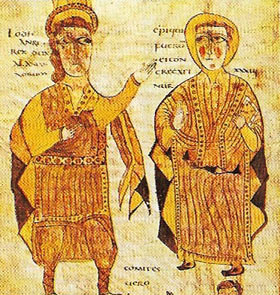 |
| The Breviary of Alaric II, king of the Visigoths, an illuminated detail of which is shown here, is a collection of Roman law. Alaric's capital was Toulouse and his kingdom stretched into Spain. The breviary, which was completed in 506, is an important source of late Roman law and is the result of an established Arian German barbarian king seeking to codify and reconcile his native tribal law with that of the lands of the old Roman Empire over which he found himself ruling. |
In 406 vast armies of Vandals, Sueves, and Alans crossed the Rhine into Gaul which was already troubled by internal conflicts in the imperial administrations. External attack and internal conflict led to the withdrawal of the last legions from Britain where the Angles, Saxons and Jutes were now free to invade. The Vandals ravaged Gaul, moved into Spain in 408 and, in 429 under the leadership of Gaiseric (c. 390–477), Accomplished the most crippling blow of all to the Western Empire – invasion of Africa. In 442 Gaiseric was recognized as the independent ruler of North Africa on which Rome depended for the bulk of her food.
The first German empires
By 416 the Burgundians in Gaul had established the first German kingdoms within the old imperial frontiers and with the Franks scattered across northern France the pattern of post-Roman Western Europe was beginning to emerge. But any hopes of peace were shattered by the Huns, who for nearly a century had been stable in what is now Hungary. Threatening east and west alike and building up an enforced alliance of subject German peoples. In 450 the empire refused to buy off the Huns with any more gold so, led by Attila, (c. 406–453), they invaded Gaul. The Huns, with their powerful horses and incredible stamina were considered almost invincible and we're only halted near Troyes in 452 when the Franks and the Visigoths joined forces with the Romans. Attila turned south and menaced Rome, but died in 453 (Figure 5). The destruction was widespread but the Germans had saved the legacy of Roman civilization in the west.
The Franks gradually consolidated their power in Gaul. Under Clovis I (465–511) they created a United and non-heretical Christian Gaul (Council of Orleans, 511) and Clovis was recognized by the Eastern emperor as the ruler of a country that roughly corresponds to modern France. He was baptized following his victory over the Alemanni.
After the deposition of Augustulus, the last Western emperor, in 476, the German soldier Ocoacer (died 493) became the ruler of Italy. Meanwhile the Ostrogoths had left the Black Sea and after the downfall of the Huns had moved into Pannonia and thence to Illyricum. Led by Theodoric from 471 they ravaged Macedonia and Thessaly and in 487 marched on Constantinople. Theodoric was bought of by the emperor Zeno, who persuaded him to go to Italy and overthrow Odoacer. Theodoric defeated Oroacer on the River Adda in 490 and after a three-year siege of Ravenna Oroacer gave in. Theodoric assassinated him, and established the Ostrogothic kingdom in Italy.
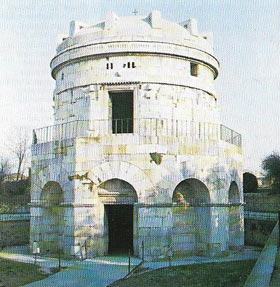 |
| The Mausoleum of Theodoric is the tomb of the first king of Ostrogothic Italy. It was built about 530 and is circular in shape, surmounted by a monolithic dome of Istrian alone weighing 477 tons. |
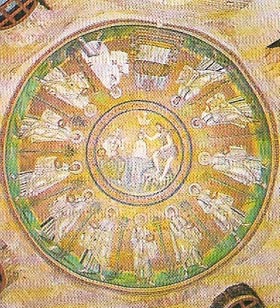 |
| German barbarians, when converted to Christianity, adopted the Arian heresy that denied the divinity of Christ. Theoderic, having established the capital of his Italian kingdom at Ravenna, built an Arian cathedral and baptistery. The mosaics on the baptistery show the formalized presentation of the Baptism of Christ with the Apostles moving toward an altar-throne; a scene, the Etimasia, taken from the fourth chapter of the Apocalypse. The existence of Arian and Catholic buildings side by side in the same city exemplifies the spirit of coexistence that prevailed in Theoderic's Italy. |
The Eastern Empire
The Eastern Empire averted most dangers from the Germans and the Huns by passing them over to the west, but the Balkans were ruined and depopulated and the Bulgars were able to threaten Constantinople in 493 and 499. In the east the emperor Justinian (c. 482–565) fought for 35 years against the Persian king Chosroes (reigned 531–579). The balance of power in the Mediterranean was temporarily reversed by Justinian's re conquest of Africa (533–534) and Italy (536–554); yet all of this effort was wasted when in the following century, the Arabs overran all imperial lands from the Middle East to North Africa, besieging Constantinople annually until their fleet's defeat there in 718.
